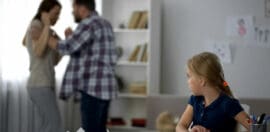Equal blame? The dangers of couples counselling in a domestic violence situation

16 May 2019 at 8:35 am
Funding in the federal budget for broad-based counselling and dispute resolution has triggered outrage and sighs of disbelief from many working in the sector.
Jane sat in a room across from a counsellor and her aggressor.
With the three of them almost in a circle, all facing each other, the counsellor began to ask about their relationship as husband and wife.
“I felt like I couldn’t speak,” Jane* recalls.
“I’m sitting there thinking, anything I say I have to be answerable to that. So I cushioned everything that I said, every word, every phrase, I made it sound like it was an argument more than it was an assault.
“I remember leaving the third session – I think we got to three – and my husband was in the carpark. And he was so angry. He said ‘I’m never coming back here again’. And I thought, gosh, I have to go home to this.”
On average, one woman a week is murdered by her current or former partner in Australia, with intimate partner violence being one of the leading contributors to illness, disability and premature death for women aged 15 to 44.
In this year’s federal budget, the government earmarked $328 million as part of the 12-year National Plan to Reduce Violence Against Women and their Children.
Yet, within the funding package, $10 million was set aside for Specialist Family Violence Services, including broad-based counselling and dispute resolution – something which has triggered outrage and sighs of disbelief from many working in the sector.
Among the concerns from advocates is that couples counselling by nature attempts to understand both perspectives. This dynamic can fail to hold the perpetrator accountable for their actions, and puts the onus back on the victim.
Hayley Foster is the director of Women’s Domestic Violence Court Advocacy Services NSW. She says it “flies in the face” of years of consultation with women’s safety experts and survivors of domestic, family and sexual violence.
“Nowhere is there the suggestion that we should be going back to the days where we are recommending couples counselling or couples mediation in the context of family violence,” Foster says.
“Except in the case of highly specialised family dispute resolution for family law matters involving specialist legal and domestic violence services.”
Following the budget announcement, advocates called on the government to reconsider the funding.
But, a month on, it is still set to go ahead.
Applications for a grant under the scheme – open to a select list of organisations that provide family relationship services – closed on Wednesday.
Foster notes that the grant guidelines did not specify any requirement for a gender-responsive approach consistent with specialist women’s domestic violence services nor a requirement to meet standards for men’s behaviour change.
There was also no requirement that the relationship service have experience delivering specialist domestic violence services.
“The unfortunate truth is that expanding services which invite families to undertake couples counselling or mediation in the context of domestic violence, outside of a highly specialised environment with the appropriate safeguards and supports, will put women and children’s safety at risk,” Foster says.
These concerns have been echoed by Doctors against Violence towards Women (DAVTW), a group of over 350 qualified doctors, which criticised the move as “ill informed and dangerous”.
The group maintain that studies on couples counselling in family violence, have shown almost half of the patients were worse off, suffering increased distress, violence and risk of death, and that couples counselling can stop women from leaving violent situations.
DAVTW has also raised concerns that the program was limited to primarily Christian (close to half of the organisations invited to apply to deliver the counselling are faith-based), and otherwise unqualified, untrained groups .
Dr Karen Williams, leader of DAVTW and an experienced psychiatrist, specialising in trauma, says inadequately trained counsellors may not question the distorted view they receive and could treat the family situation with “inappropriate optimism”.
She says women often minimise their partners abuse, to protect themselves and their partners – this is especially true when interviewed with their partner in the room.
“Perpetrators are often very good at presenting a charming, friendly face and frequently deny and minimise their actions or blame them on the victim,” Williams said.
Jane says she blames couples counselling for being part of the reason she stayed in her relationship so long.
She says it is important for counsellors to realise that they are dealing with vulnerable women, and they could be giving them a reason to stay.
“If you’re trying to make a decision about leaving or staying at that time, there needs to be an impetus and it needs to be a strong one,” Jane says.
“That’s why domestic violence is such a difficult head wreck. That love, that bond of being together for 15 or 20 years is still there and you want the children to have a father and at times they are normal people, they are lovely and do all the nice things.
“You think, I can do this if we just both put more effort in, or I put more effort in. It’s about salvaging something that’s really special and feeling scared and alone as well, and not wanting to leave and inflame them.”
Studies have shown that the longer a victim/survivor is in a violent relationship, the more likely she is to remain. When women finally seek help, it is often due to fear of emotional and physical harm to their children.
For this reason, best practice in working with couples in the context of domestic violence is a safety first approach.
Sadly, Jane says when she needed help there were “so many gaps” in the support, that things got worse before they got better.
She believes that if someone had tried to help her leave, she would have taken it. Instead she was referred to a women’s health service and the counsellor there decided that it was worth “trying to salvage the relationship”.
“It was deemed that that would be a good outcome,” Jane says.
Once in the room, her complaints were not taken seriously and she was told she had to work harder on the relationship.
“I did actually mention the fact that there had been some physical interactions, where he grabbed me around the throat. But that wasn’t taken seriously,” Jane says.
“It wasn’t seen as assault, perhaps a little bit of fisticuffs or something, tit for tat. But actually it wasn’t like that at all.”
Jane says her husband had actually threatened to kill their children.
When she confronted him, he tried to strangle her.
“He rattled his keys in his pocket and said ‘Come on kids’. And I thought he would take them, as he’d threatened. And so I chased him down the hall and just grabbed the back of his shirt,” she says.
“I was thinking, I don’t really know what to do and I’m just going to try and stop him. And he just turned around and picked me up like I was a piece of lettuce and smashed my head into the wall.
“He dragged me into the bathroom and then started strangling me. But he closed the door before he did that. So he knew what he was doing.
“None of that obviously came out with the couple’s counselling of course.”
Jane says the whole process left her feeling confused and like she had done something wrong.
She was led to believe that it was her responsibility to rehabilitate her husband, and that she was part of the problem.
“I’d put him under too much stress because I was studying and because we had three children and one with a disability,” she says.
“So I stayed. My self-worth crumbled. My days and my life revolved around protecting the children, shushing them, avoiding conflict by apologising and making allowances, and smiling through the tears, time and time again.
“I stayed for nine more years despite my fears, because I was told that I was part of the reason for the abuse.”
Jane says she feels “a bit ripped off”, that her counsellor, who came highly recommended, did not undertake the proper protocols.
“I had been referred from another service, so they would have told them what the issue was,” she says.
“He should have seen myself and my husband first separately to tease out what the issues were, and then seen us together. But he didn’t.
“That first meeting was when we were together and he asked about what had been happening.”
*Jane’s name has been changed to protect her identity.
If you or someone you know is impacted by sexual assault, family or domestic violence, call 1800RESPECT on 1800 737 732 or visit www.1800RESPECT.org.au. In an emergency, call 000.







